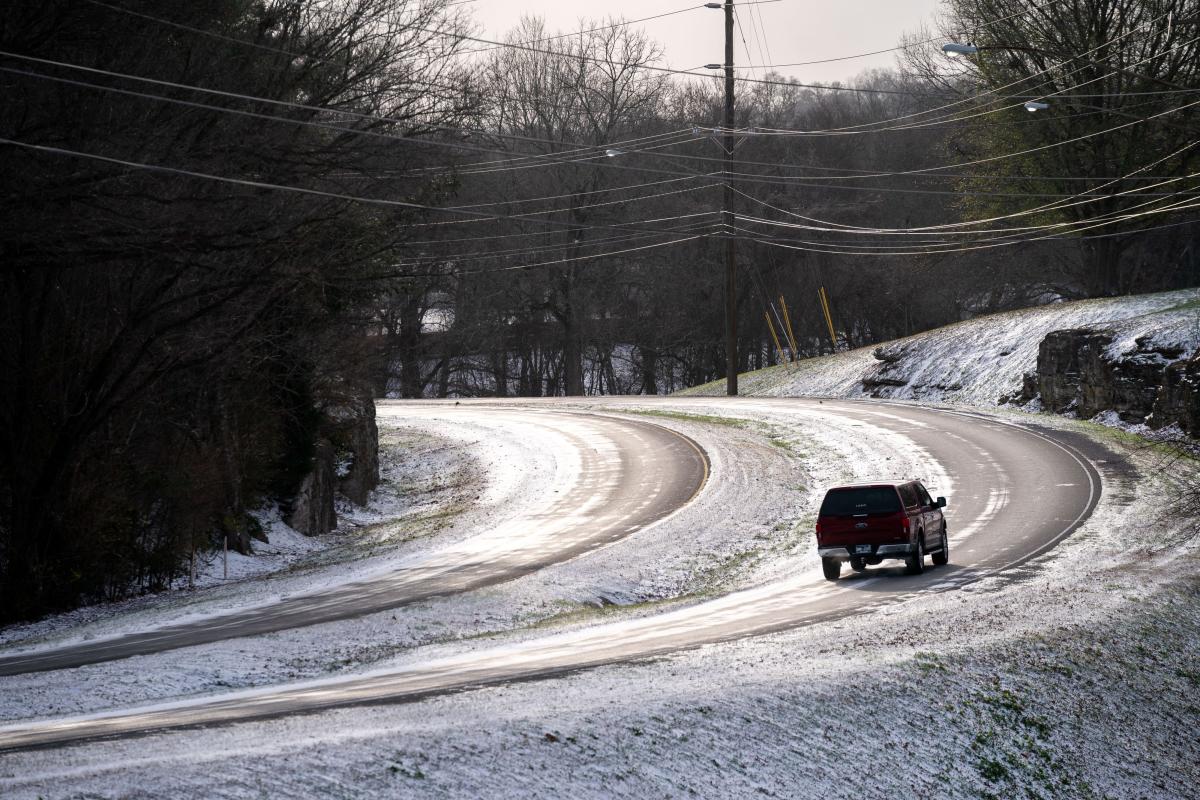
Travel is expected to be significantly impacted on Friday, as a major winter storm is set to blanket the entire Middle Tennessee region.
Most areas are likely to receive between four to eight inches of snow according to the National Weather Service.
Both federal and state agencies continue to advise against travel on Friday. Travel is anticipated to become “very difficult” by the mid to late morning and although much of the snow will move out by Friday night, travel impacts will continue Saturday.
Advertisement
Advertisement
Freezing weekend temperatures on Saturday will cause lingering snow to melt during the day which is expected to re-freeze at night through the weekend resulting in black ice and continued hazardous travel especially on secondary roads, said the weather service.
How to check Nashville road conditions
Road conditions on state highways and major roads can be checked online using the Tennessee Department of Transportation’s Smartway cameras.
What to expect on Nashville’s primary and secondary roads
The Nashville Department of Transportation completed pre-treating roads on Thursday. Crews will be on standby to salt and plow roadways on Friday and will work in 12-hour shifts throughout the event until routes are clear, said a news release.
“We’ve got more snowplows ready to go on more routes than ever before,” said Mayor O’Connell in a news release. “My hope is all Nashvillians will stay weather-aware, and exercise patience. If we do have a winter storm event, we will be ready.”
Advertisement
Advertisement
Diana Alarcon, Director of NDOT, said the department is fully equipped to respond to the incoming winter weather.
“We have 40 snowplow trucks ready with crews to ensure that first responders can get to people and public transit can run safely on any detours,” said Alarcon in a statement. “We encourage everyone to give our crews plenty of room to work, to stay off roads if possible, and if you must travel during the snow, drive slowly and cautiously.”
Primary, secondary and post-secondary snow routes can be found online at nashville.gov. Primary routes are the first priority and will be cleared before other routes.
Tennessee officials prep, warn drivers to ‘stay off the road’
TDOT crews have been preparing Tennessee roadways for Friday’s snow event since Wednesday, brining heavily traveled interstates and state routes, as well as areas vulnerable to freezing, such as hills, curves, ramps, bridges, and interchanges, said a news release.
Advertisement
Advertisement
More in U.S.
TDOT is also anticipating running extended HELP routes on Interstate 40 eastbound to the Putnam County line, Interstate 40 westbound to the Tennessee River as well as Interstate 65 and Interstate 24 to the Kentucky state line.
.@myTDOT crews are finishing up brining roadways today ahead of tomorrow’s snow event. Here’s a look at brine application on SR 50 in Maury County. Remember: please give our crews room to work! pic.twitter.com/z3mWDuw2nn
— ErinTDOT (@ErinTDOT) January 9, 2025
The department, along with the weather service, is strongly discouraging travel on Friday.
“When snow hits Tennessee, TDOT ice and snow removal teams focus first on clearing interstates and heavily traveled state routes. During prolonged weather events, crews may have to clear roadways repeatedly,” said TDOT in a news release.
“Equipment will be staged in various locations for quicker response time, and tools like chainsaws will be ready to be utilized in the event of downed trees on the roadway.”
How to prepare for winter road conditions, according to the AAA
The American Automobile Association (AAA) is encouraging drivers to exercise caution and preparedness ahead of Friday’s snow event.
Advertisement
Advertisement
“We’re urging drivers to follow the advice of local authorities and stay home if weather conditions begin to deteriorate,” said Megan Cooper, spokesperson for AAA – The Auto Club Group in a news release. “If you must get on the road, be sure to have at least a half tank of gas, significantly reduce your speed and stay off closed roads.”
If travel is necessary, AAA recommends the following:
-
Pack a well-stocked emergency kit – Make sure it is equipped with a cell phone car charger, first-aid kit, extra blankets, hats, gloves and coats, drinking water, non-perishable snacks, flashlights and extra batteries, reflective warning triangles, and an ice scraper or snow brush.
-
Always drive at a safe speed – Even if that means driving below the posted speed limit.
-
Compensate for reduced traction – Increase your following distances (normally three to four seconds) to eight to ten seconds.
-
Allow sufficient room for maintenance vehicles by staying at least 200 feet back – If you need to pass, go to the other vehicle’s left.
-
Watch for icy surfaces on bridges and intersections – even if the rest of the road seems to be in good condition.
-
Avoid braking on ice – If you’re approaching a patch of ice, brake during your approach. Control the skid. Applying pressure to your brakes while on ice will throw your car into a skid.
-
If you get stuck in snow or ice, straighten the wheel and accelerate slowly – Add sand or kitty litter under the drive wheels to help avoid spinning the tires.
-
If your tires lose traction, continue to look and steer in the direction you want to go – If the drive wheels start to spin or slide while going up a hill, ease off the accelerator slightly and then gently resume speed.
-
Slow down and move over – Avoid driving on shoulders or medians so first responders, tow truck operators and emergency vehicles can get to stranded motorists who are in dangerous roadside conditions.
Should you find yourself stranded by the roadside, AAA recommends the following:
-
Stay in the vehicle – Your car can provide shelter, allowing emergency responders to best locate you and prevent you from being struck by an approaching vehicle.
-
To make the gas last longer, don’t leave the car running. If there is an extended traffic jam, turn off the engine for a period, then back on to reheat the inside, when it has gotten too cold again. Make sure the exhaust pipe is snow-free.
-
Avoid driving on the shoulders or medians of highways to get around the traffic jam – These need to be kept clear for first responders, tow trucks and emergency vehicles to get to the cause of the stoppage.
-
Cold weather can shorten the range of electric vehicles – EV drivers should plan for more frequent stops for charging and identify the location of charging stations before they hit the road. AAA recommends “pre-heating” the inside of an electric vehicle to a comfortable temperature while still connected to the charger, this will reduce the vehicle’s battery demand to regulate cabin temperature at the onset of driving.
Diana Leyva covers trending news and service journalism for The Tennessean. Contact her at Dleyva@gannett.com or follow her on X, the platform formerly known as Twitter, at @_leyvadiana
This article originally appeared on Nashville Tennessean: Nashville road conditions: What to know when driving in the snow
EMEA Tribune is not involved in this news article, it is taken from our partners and or from the News Agencies. Copyright and Credit go to the News Agencies, email news@emeatribune.com Follow our WhatsApp verified Channel




